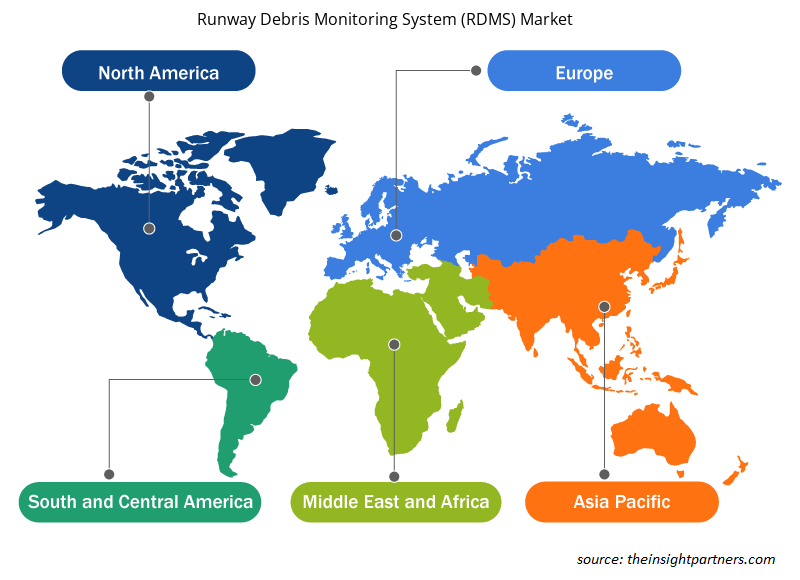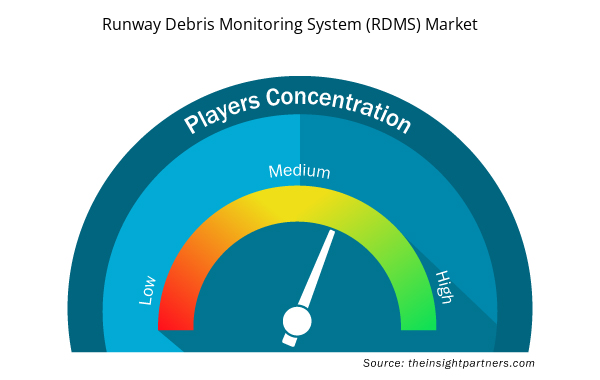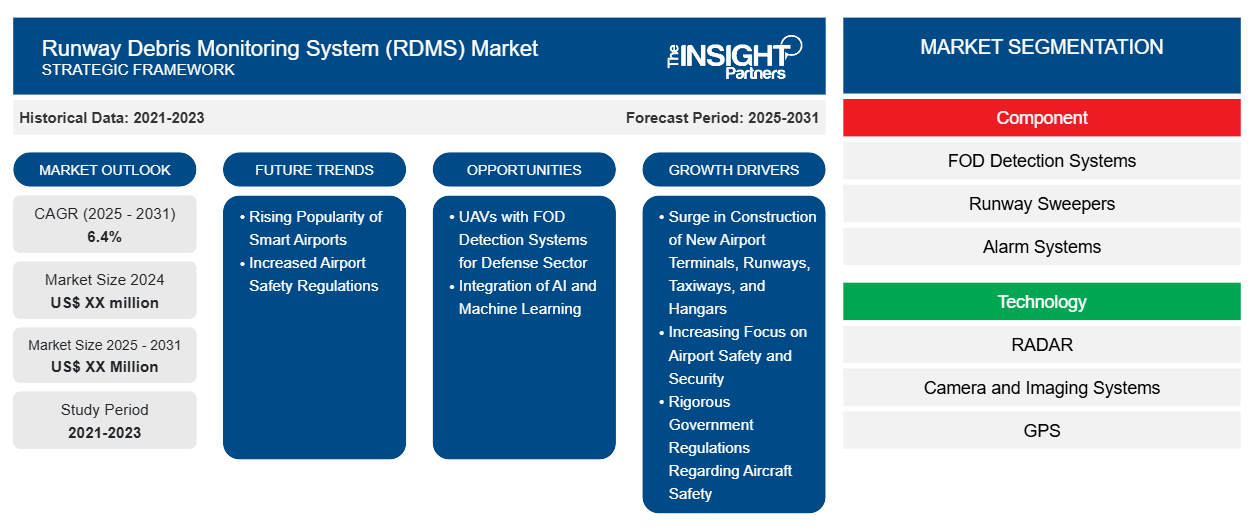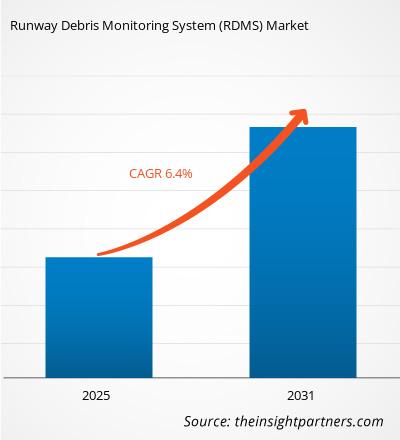滑走路残骸監視システム (RDMS) 市場は、2023 年から 2031 年にかけて 6.4% の CAGR を記録し、市場規模は 2023 年の XX 百万米ドルから 2031 年には XX 百万米ドルに拡大すると予想されています。
レポートは、コンポーネント(FOD検出システム、滑走路清掃車、警報システム、その他)、テクノロジー(レーダー、カメラおよび画像システム、GPS、レーザー、その他)、アプリケーション(検出、識別、リスク評価、除去、分析、その他)、プラットフォーム(固定、モバイル)別にセグメント化されています。グローバル分析は、地域レベルと主要国でさらに細分化されています。レポートは、上記の分析とセグメントに対してUSDでの価値を提供します。
報告書の目的
The Insight Partners によるレポート「滑走路残骸監視システム (RDMS) 市場」は、現在の状況と将来の成長、主な推進要因、課題、機会を説明することを目的としています。これにより、次のようなさまざまなビジネス関係者に洞察が提供されます。
- テクノロジープロバイダー/メーカー: 進化する市場の動向を理解し、潜在的な成長機会を把握することで、情報に基づいた戦略的意思決定が可能になります。
- 投資家: 市場の成長率、市場の財務予測、バリュー チェーン全体に存在する機会に関する包括的な傾向分析を実施します。
- 規制機関: 市場の濫用を最小限に抑え、投資家の信用と信頼を維持し、市場の完全性と安定性を維持することを目的として、市場における政策と警察活動を規制します。
滑走路デブリ監視システム (RDMS) 市場のセグメンテーション
成分
- FOD検出システム
- 滑走路清掃員
- 警報システム
- その他
テクノロジー
- レーダー
- カメラおよび画像システム
- GPS
- レーザ
- その他。
応用
- 検出
- 識別
- リスクアセスメント
- 除去
- 分析
- その他
プラットフォーム
- 修理済み
- 携帯
プラットフォーム
- 修理済み
- 携帯
要件に合わせてレポートをカスタマイズする
このレポートの一部、国レベルの分析、Excelデータパックなど、あらゆるレポートを無料でカスタマイズできます。また、スタートアップや大学向けのお得なオファーや割引もご利用いただけます。
- このレポートの主要な市場動向を入手してください。この無料サンプルには、市場動向から見積もりや予測に至るまでのデータ分析が含まれます。
滑走路残骸監視システム (RDMS) 市場の成長要因
- 新しい空港ターミナル、滑走路、誘導路、格納庫の建設の急増:世界的な商用航空機艦隊の増加は、世界中で増加する旅客交通量に対応するために、さまざまな空港で新しいフライト、ターミナル、滑走路、格納庫の需要を生み出す主な要因の1つです。これにより、空港当局は、膨大な数の航空機に対応できるようにそれぞれの空港施設をアップグレードするための投資を促進し、空港全体の運用効率も向上します。2021年5月、関西国際空港(KIX)は、年間約4,000万人の国際旅客の管理に重点を置いた拡張プロジェクトを開始しました。このプロジェクトは、関西で開催される2025年大阪万博までに完了する予定です。このように、新しい空港ターミナル、滑走路、誘導路、格納庫の建設は、滑走路デブリ監視システム市場の成長に貢献しています。
- 空港の安全とセキュリティへの注目の高まり: 滑走路上の異物破片 (FOD) による安全リスクへの懸念が高まる中、空港と航空当局は高度な破片監視システムに投資しています。滑走路での事故を防ぎ、運用効率を改善し、より厳しい安全規制に準拠する必要性から、これらのシステムの需要が高まっています。
航空機の安全性に関する厳格な政府規制: FOD (異物破片) の存在は、空港での継続的な懸念事項です。連邦航空局 (FAA) は、空港滑走路異物破片 (FOD) 検出システムの製造と調達に関するガイドラインを示しました。すべての顧客と製造者は、FOD 検出システムの入手と製造に関して FAA が設定した基準に従う必要があります。航空会社、空港、および一般航空コミュニティは、AC 150/5210-24 に従い、効果的な FOD 管理プログラムに参加することで、FOD を最小限に抑えるための重要な措置を講じています。 FAA 異物破片プログラムの回覧文書、例えば AC 150/5210-24、空港異物破片 (FOD) 管理では、FOD を、空港環境内の不適切な場所にある、生きているかどうかに関わらず、空港や航空会社の職員に危害を与えたり、航空機に損傷を与えたりする可能性のあるあらゆる物体と定義しています。したがって、航空機の安全性に関する厳格な政府規制が、滑走路破片監視システム市場を牽引しています。
滑走路デブリ監視システム (RDMS) 市場の将来動向
- スマート空港の人気の高まり: 政府当局がスマート空港に傾倒する傾向が強まるにつれ、空港敷地内でのスマート システムの実装に対する需要が高まっています。米国、英国、中国などの先進国の政府は、リアルタイム情報への関心が高まり、空港運営における高度な接続技術に対する需要が高まっているため、通信およびネットワーク システム、スマート センサー、カメラ、RFID タグ、ウェアラブルなどのスマート空港技術を活用しています。したがって、スマート空港への注目が高まることで、予測期間中に滑走路デブリ監視システム市場の成長に有利な機会が生まれると予想されます。
- 空港の安全規制の強化: 世界中の航空当局が安全基準を厳しくするにつれ、コンプライアンス要件を満たす高度な破片監視システムの機会が拡大しています。空港は、滑走路の安全を確保し、異物破片 (FOD) によるコストのかかる遅延や事故を回避するために、新しいテクノロジーに投資するでしょう。
滑走路デブリ監視システム (RDMS) の市場機会
- 防衛分野向けFOD検出システムを備えたUAV:監視、戦闘作戦、輸送と配達、戦闘被害管理などの用途で軍人による無人航空機(UAV)の導入が増加しています。たとえば、2024年5月、SkyLark LabsはMercedes-Benz India Pvt. Ltd.と協力し、人工知能(AI)駆動型モバイル異物デブリシステムを活用しました。FOD検出システムは、主にiDEX Defence Innovation Organizationの下でインド海軍向けに開発されました。この高度なソリューションは高度な自己学習能力を備えており、パフォーマンスを継続的にアップグレードし、変化するFODの状況に応じて修正することができます。したがって、防衛分野向けのUAVとFOD検出システムの統合は、今後数年間で滑走路デブリ監視システム市場に新たなトレンドをもたらすと予想されます。
- AI と機械学習の統合: 最新の滑走路破片監視システムでは、破片のリアルタイム検出と分析を強化するために、AI と機械学習アルゴリズムがますます取り入れられています。これらのテクノロジーは、潜在的な脅威を迅速に特定し、対応時間を短縮し、空港の安全プロトコルを改善するのに役立ちます。
滑走路デブリ監視システム (RDMS) 市場の地域別分析
予測期間を通じて滑走路残骸監視システム (RDMS) 市場に影響を与える地域的な傾向と要因は、Insight Partners のアナリストによって徹底的に説明されています。このセクションでは、北米、ヨーロッパ、アジア太平洋、中東およびアフリカ、南米および中米にわたる滑走路残骸監視システム (RDMS) 市場のセグメントと地理についても説明します。

- 滑走路デブリ監視システム(RDMS)市場の地域別データを入手
滑走路デブリ監視システム(RDMS)市場レポートの範囲
| レポート属性 | 詳細 |
|---|---|
| 2023年の市場規模 | XX百万米ドル |
| 2031年までの市場規模 | XX百万米ドル |
| 世界のCAGR(2023年~2031年) | 6.4% |
| 履歴データ | 2021-2022 |
| 予測期間 | 2024-2031 |
| 対象セグメント | コンポーネント別
|
| 対象地域と国 | 北米
|
| 市場リーダーと主要企業プロフィール |
|
滑走路デブリ監視システム(RDMS)市場のプレーヤー密度:ビジネスダイナミクスへの影響を理解する
滑走路残骸監視システム (RDMS) 市場は、消費者の嗜好の変化、技術の進歩、製品の利点に対する認識の高まりなどの要因により、エンドユーザーの需要が高まり、急速に成長しています。需要が高まるにつれて、企業は提供を拡大し、消費者のニーズを満たすために革新し、新たなトレンドを活用し、市場の成長をさらに促進しています。
市場プレーヤー密度とは、特定の市場または業界内で活動している企業または会社の分布を指します。これは、特定の市場スペースに、その市場規模または総市場価値に対してどれだけの競合相手 (市場プレーヤー) が存在するかを示します。
滑走路残骸監視システム (RDMS) 市場で事業を展開している主要企業は次のとおりです。
- ナブテックレーダー
- キネティQ
- タレスグループ
- ムーグ株式会社
- ラインメタルAG
免責事項:上記の企業は、特定の順序でランク付けされていません。

- 滑走路残骸監視システム(RDMS)市場のトップキープレーヤーの概要を入手
主なセールスポイント
- 包括的なカバレッジ: レポートでは、滑走路残骸監視システム (RDMS) 市場の製品、サービス、タイプ、エンドユーザーの分析を包括的にカバーし、全体的な展望を提供します。
- 専門家による分析: レポートは、業界の専門家とアナリストの深い理解に基づいてまとめられています。
- 最新情報: このレポートは、最新の情報とデータの傾向を網羅しているため、ビジネスの関連性を保証します。
- カスタマイズ オプション: このレポートは、特定のクライアント要件に対応し、ビジネス戦略に適切に適合するようにカスタマイズできます。
したがって、滑走路デブリ監視システム (RDMS) 市場に関する調査レポートは、業界のシナリオと成長の見通しを解読して理解する道の先導役となる可能性があります。いくつかの正当な懸念があるかもしれませんが、このレポートの全体的な利点は欠点を上回る傾向があります。
- 過去2年間の分析、基準年、CAGRによる予測(7年間)
- PEST分析とSWOT分析
- 市場規模価値/数量 - 世界、地域、国
- 業界と競争環境
- Excel データセット



Report Coverage
Revenue forecast, Company Analysis, Industry landscape, Growth factors, and Trends

Segment Covered
This text is related
to segments covered.

Regional Scope
North America, Europe, Asia Pacific, Middle East & Africa, South & Central America

Country Scope
This text is related
to country scope.
よくある質問
The report can be delivered in PDF/PPT format; we can also share excel dataset based on the request.
Some of the customization options available based on the request are an additional 3-5 company profiles and country-specific analysis of 3-5 countries of your choice. Customizations are to be requested/discussed before making final order confirmation, as our team would review the same and check the feasibility.
Rising Popularity of Smart Airports is the key future trend of the Runway Debris Monitoring System (RDMS) Market
The leading players operating in the Runway Debris Monitoring System (RDMS) Market include ArgosAI Teknoloji A.?.; Moog Inc.; Navtech Radar; Pavemetrics; Plextek Services Limited; Rheinmetall AG; QinetiQ Group Plc; Thales SA; Xsight Systems Ltd.; Trex Aviation Systems; Varec, Inc.; Smiths Detection Group Ltd. (Smiths Group plc); Infologic Pte Ltd.; Skylarklabs, Inc.; Hitachi Ltd
The Runway Debris Monitoring System (RDMS) Market is estimated to witness a CAGR of 6.4% from 2023 to 2031
The major factors driving the Runway Debris Monitoring System (RDMS) Market are: Surge in Construction of New Airport Terminals, Runways, Taxiways, and Hangars and Rigorous Government Regulations Regarding Aircraft Safety
Trends and growth analysis reports related to Aerospace and Defense : READ MORE..
1. Navtech Radar
2. QinetiQ
3. Thales Group
4. Moog Inc.
5. Rheinmetall AG
6. Varec, Inc. (Leidos)
7. Pavemetrics
8. Xsight Systems
9. Rolls-Royce plc
10. WAVE TECH Co.,Ltd.
The Insight Partners performs research in 4 major stages: Data Collection & Secondary Research, Primary Research, Data Analysis and Data Triangulation & Final Review.
- Data Collection and Secondary Research:
As a market research and consulting firm operating from a decade, we have published and advised several client across the globe. First step for any study will start with an assessment of currently available data and insights from existing reports. Further, historical and current market information is collected from Investor Presentations, Annual Reports, SEC Filings, etc., and other information related to company’s performance and market positioning are gathered from Paid Databases (Factiva, Hoovers, and Reuters) and various other publications available in public domain.
Several associations trade associates, technical forums, institutes, societies and organization are accessed to gain technical as well as market related insights through their publications such as research papers, blogs and press releases related to the studies are referred to get cues about the market. Further, white papers, journals, magazines, and other news articles published in last 3 years are scrutinized and analyzed to understand the current market trends.
- Primary Research:
The primarily interview analysis comprise of data obtained from industry participants interview and answers to survey questions gathered by in-house primary team.
For primary research, interviews are conducted with industry experts/CEOs/Marketing Managers/VPs/Subject Matter Experts from both demand and supply side to get a 360-degree view of the market. The primary team conducts several interviews based on the complexity of the markets to understand the various market trends and dynamics which makes research more credible and precise.
A typical research interview fulfils the following functions:
- Provides first-hand information on the market size, market trends, growth trends, competitive landscape, and outlook
- Validates and strengthens in-house secondary research findings
- Develops the analysis team’s expertise and market understanding
Primary research involves email interactions and telephone interviews for each market, category, segment, and sub-segment across geographies. The participants who typically take part in such a process include, but are not limited to:
- Industry participants: VPs, business development managers, market intelligence managers and national sales managers
- Outside experts: Valuation experts, research analysts and key opinion leaders specializing in the electronics and semiconductor industry.
Below is the breakup of our primary respondents by company, designation, and region:

Once we receive the confirmation from primary research sources or primary respondents, we finalize the base year market estimation and forecast the data as per the macroeconomic and microeconomic factors assessed during data collection.
- Data Analysis:
Once data is validated through both secondary as well as primary respondents, we finalize the market estimations by hypothesis formulation and factor analysis at regional and country level.
- Macro-Economic Factor Analysis:
We analyse macroeconomic indicators such the gross domestic product (GDP), increase in the demand for goods and services across industries, technological advancement, regional economic growth, governmental policies, the influence of COVID-19, PEST analysis, and other aspects. This analysis aids in setting benchmarks for various nations/regions and approximating market splits. Additionally, the general trend of the aforementioned components aid in determining the market's development possibilities.
- Country Level Data:
Various factors that are especially aligned to the country are taken into account to determine the market size for a certain area and country, including the presence of vendors, such as headquarters and offices, the country's GDP, demand patterns, and industry growth. To comprehend the market dynamics for the nation, a number of growth variables, inhibitors, application areas, and current market trends are researched. The aforementioned elements aid in determining the country's overall market's growth potential.
- Company Profile:
The “Table of Contents” is formulated by listing and analyzing more than 25 - 30 companies operating in the market ecosystem across geographies. However, we profile only 10 companies as a standard practice in our syndicate reports. These 10 companies comprise leading, emerging, and regional players. Nonetheless, our analysis is not restricted to the 10 listed companies, we also analyze other companies present in the market to develop a holistic view and understand the prevailing trends. The “Company Profiles” section in the report covers key facts, business description, products & services, financial information, SWOT analysis, and key developments. The financial information presented is extracted from the annual reports and official documents of the publicly listed companies. Upon collecting the information for the sections of respective companies, we verify them via various primary sources and then compile the data in respective company profiles. The company level information helps us in deriving the base number as well as in forecasting the market size.
- Developing Base Number:
Aggregation of sales statistics (2020-2022) and macro-economic factor, and other secondary and primary research insights are utilized to arrive at base number and related market shares for 2022. The data gaps are identified in this step and relevant market data is analyzed, collected from paid primary interviews or databases. On finalizing the base year market size, forecasts are developed on the basis of macro-economic, industry and market growth factors and company level analysis.
- Data Triangulation and Final Review:
The market findings and base year market size calculations are validated from supply as well as demand side. Demand side validations are based on macro-economic factor analysis and benchmarks for respective regions and countries. In case of supply side validations, revenues of major companies are estimated (in case not available) based on industry benchmark, approximate number of employees, product portfolio, and primary interviews revenues are gathered. Further revenue from target product/service segment is assessed to avoid overshooting of market statistics. In case of heavy deviations between supply and demand side values, all thes steps are repeated to achieve synchronization.
We follow an iterative model, wherein we share our research findings with Subject Matter Experts (SME’s) and Key Opinion Leaders (KOLs) until consensus view of the market is not formulated – this model negates any drastic deviation in the opinions of experts. Only validated and universally acceptable research findings are quoted in our reports.
We have important check points that we use to validate our research findings – which we call – data triangulation, where we validate the information, we generate from secondary sources with primary interviews and then we re-validate with our internal data bases and Subject matter experts. This comprehensive model enables us to deliver high quality, reliable data in shortest possible time.


 このレポートの無料サンプルを入手する
このレポートの無料サンプルを入手する